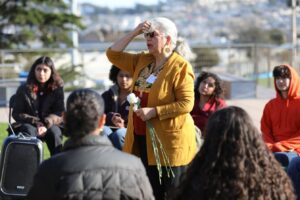Since October 2021, when California became the first state to add Ethnic Studies to graduation requirements, schools have begun integrating the class into their curriculums. While public schools are required to teach the class by 2025, many private schools in the Bay Area, regardless of not being mandated to comply with this legislation, are exploring ways to teach Ethnic Studies.
Dr. Alain Sykes, Dean of Equity and Social Impact at the Drew School, reflects on the challenges and opportunities of implementing Ethnic Studies in private schools. “To what extent can you have deep social justice or deep equity within an institution that is designed to protect privilege, at least historically? In order to try to create changes within society, it’s important to teach these topics and to engage with them,” she said. In San Francisco, some private schools like Urban School of San Francisco and Lick-Wilmerding High School currently teach Ethnic Studies, while others, such as the Drew School, have yet to adopt the course.
The Ethnic Studies movement began in 1968 with a revolution at San Francisco State University (SFSU). As the enrollment of students of color dropped at SFSU, they began to pressure the administration, demanding to have their history taught. When George Murray, the minister of education for the Black Panther Party and a popular English teacher at SFSU, was suspended from campus, students went on strike, drafting demands and boycotting classes, causing the school to close down for 5 months until their demands were met. The university ended the strike in March of 1969 and promised to admit almost all non-white applicants and create a college of Ethnic Studies in the upcoming school year.

photo courtesy of SFPL
Since then, California has been a global leader in the Ethnic Studies movement. In 2010, San Francisco United School District (SFUSD) passed a school board policy to implement Ethnic Studies as an optional class, making San Francisco one of the first school districts in the U.S. to teach Ethnic Studies. By 2014, SFUSD administrators saw evidence from a Stanford University study showing that Ethnic Studies had positive impacts on students’ attendance and achievement, and it pushed the district to pass a school board policy that mandates an Ethnic Studies class for all 9th graders in 2015.
Starting in 2025, California will become the first state to make Ethnic Studies a graduation requirement for all public high school students. Assembly Bill 101, authored by former Assemblymember José Medina (D-Riverside), calls for all public high schools to offer at least one Ethnic Studies course by the 2025-2026 school year and have a mandatory one-semester Ethnic Studies class by the 2029-2030 school year. The bill also provides a model curriculum that schools may follow or adapt. Medina, who was partially motivated in authoring AB 101 by his experiences in school, said, “I saw the real lack of representation of other ethnicities and races in U.S. history classes.”
Many private high schools that currently teach Ethnic Studies have struggled with whether or not it should be mandatory for all students. One school that has decided to make the class mandatory for all students is the Urban School of San Francisco. As a part of their service learning curriculum, 9th grade students are required to participate in a six-week course called “Identity and Ethnic Studies,” where, according to the Urban’s website, students “explore their identity and culture, as well as examine historical factors that shape social constructs such as race, ethnicity, nationality, gender and class.”
By beginning student service learning with Ethnic Studies in 9th grade, Urban hopes to “create a shared foundation for everybody to be able to operate from, as we’re unpacking, at times challenging, powerful topics in classes like history, or English or anywhere else,” said Jason Ernest Feldman, Urban’s Dean of Equity and Inclusion.
Lick-Wilmerding High School is another example of a private high school that offers Ethnic Studies, except, unlike Urban, the class is not mandatory. In 2020, the student body of LWHS voiced the need for education on the histories of communities of color. This ask spurred the creation of the Ethnic Studies working group, a task force with student leaders, faculty, staff and administrators hoping to find the best way to make Ethnic Studies a graduation requirement at LWHS.
Through the working group’s efforts, Ethnic Studies was first offered at LWHS in the 2022-23 school year as a semester-long elective class. The class is currently taught by Kenzo Yanni Velasquez ’15 and Ravi Lau ’92.

photo courtesy of Vidigami
San Francisco, having been the birthplace of Ethnic Studies, has a higher concentration of private high schools that offer or mandate Ethnic Studies than most other school districts across the country. While many private schools in San Francisco teach Ethnic Studies, some, such as Drew School, do not. Classes at Drew are dependent on student enrollment, meaning that if there is more interest in a class in a certain year, it will be more likely to be offered.
Although Drew doesn’t specifically offer Ethnic Studies, they offer Race and Gender Studies on occasion. “One of the things that I’ve found interesting at Drew is that with classes such as Race and Gender Studies, because they are electives, the students who have taken them oftentimes are students of color, oftentimes female-identifying students,” Dr. Sykes said. Many of the students who have taken the Race and Gender Studies class voice their wish for the class to be required for all students. “A lot of the students that tend to take those elective courses, they’re the ones who are already thinking about these topics. They’re the ones who are already really engaged with thinking about identity or learning about different identities,” she said.
Velasquez, who attended LWHS as a student and was the only male Filipino student in his graduating class, brings a personal perspective to the importance of teaching Ethnic Studies at predominantly white institutions. “In my junior year, I was put in a history class where I was the darkest student in the room. I think I was the only one who strongly identified with being a student of color,” Velasquez said. “And then you have a curriculum that talks about this country’s history. But I realized, I don’t see any of my people in this.”
At LWHS, where Ethnic Studies is also not mandatory, Velasquez believes that teaching Ethnic Studies is especially important. “To really learn foundational pieces of Ethnic Studies is to be open to being held accountable for the things you have the power and privilege to change,” Velasquez said.
As discussions around Ethnic Studies continues, bills pushing widespread Ethnic Studies education are being proposed. For example, California State Assembly Bill 1255, primarily authored by Assemblywoman Wendy Carrillo, aims to set teaching credentials for Ethnic Studies teachers in public schools across California. Recently, there has been an emerging incentive for many private schools to incorporate the subject, as the University of California Board of Admissions and Relations with Schools proposed in November 2021 to include Ethnic Studies as part of the admissibility requirements for UC applicants. The proposed amendment would compel many private schools to develop an Ethnic Studies curriculum. “Why should you have to wait till you get to college to learn about your own identity?” said Assemblymember Medina.






